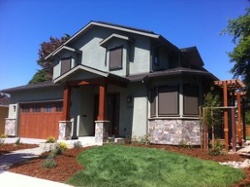
Understanding Zero-Energy Buildings
10/31/2014
Zero-energy buildings (ZEB) have zero net energy consumption. This means that the buildings consume the same amount of energy (or less) that is created on site. In order to accomplish this, they are built with decreased energy demands and use renewable energy sources to generate power and reduce greenhouse gas emissions. Zero-energy buildings are also referred to as zero net energy (ZNE) buildings, net-zero energy buildings (NZEB), or net zero buildings.
Many zero-energy buildings still use conventional grid power at certain times of the day or year when renewable sources can’t meet energy loads. These include cloudy days, nights, and shorter winter days when wind and sunlight don’t provide sufficient means for harvesting energy. However, they aim to use on-site renewables and energy conservation to address the majority of electricity, heating, and cooling needs.
How Zero-Energy Works
Energy in these buildings is often generated on-site using a number of energy-producing technologies, including solar and wind power. Additionally, these homes and buildings work to reduce the overall consumption of energy with the help of special lighting, heating/cooling/ventilation systems, and other energy-efficient technologies. As the costs of fossil fuels increase and the costs of alternative energy decrease, zero-energy as a standard for a building is an increasingly attainable goal.
Zero-Energy Systems
The optimal means to achieve zero-energy is through planning and designing a building prior to construction. By considering the whole building’s blueprints, designers and builders can implement optimal systems to ensure energy conservation and the supply of renewable energy. Zero-energy buildings often feature systems such as biomass or solar energy systems like passive heating and solar water heating.
Zero-Energy Benefits
The U.S. Energy Information Administration states that residential and commercial buildings use roughly 40 percent of the U.S.’s energy and 70 percent of its electricity. Zero-energy buildings help to reduce fossil fuel dependence, as well as reduce carbon emissions and greenhouse gases.
California’s ZNE Requirements
As an example of state initiatives, California is striving to make the state a more energy-efficient and environmentally-friendly place. The state enacted Title 24 revisions stating that by 2020, all residential buildings must conform to Zero Net Energy (ZNE) standards. Likewise, commercial buildings must be ZNE by 2030. As opposed to incentivizing strategies like incorporating better light bulbs, the Title 24 amendments set the stage for measurable, sustainable whole building energy reductions.
Setting the Zero-Energy Stage
Experts predict that the new Title 24 revisions will help to excel zero-energy building across the country, not just in California. As the ninth largest economy in the world, California’s strides toward normalizing zero-energy buildings is projected to speed nationwide development of building management and monitoring techniques. As such, the market for “smart building” is geared to see growth and accelerated adaptation.
Want more info on Zehnder America? Download our eBook to the right or click here to contact us.
